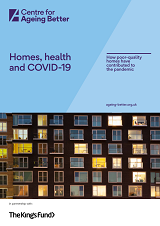Homes, health and COVID-19: How poor-quality homes have contributed to the pandemic

This report highlights the increased risk poor-quality housing has on those identified as being most at risk of COVID-19, especially in the event of another lockdown.
According to data cited in the report, 4.3 million homes in England are what the government defines as 'non-decent' putting the health and wellbeing of their estimated 10 million inhabitants at risk. Published by the Centre for Ageing Better and King's Fund, the report highlights that people who have been identified as most at risk of COVID-19, including older people, those with pre-existing health conditions and Black, Asian and Ethnic Minority groups, are more likely to be living in non-decent homes, along with those on low incomes. It also points to the issues that a winter lockdown could generate, with increased fuel bills and exacerbate fuel poverty, especially with people spending more time in their homes and struggling to keep poorly insulated homes warm for longer periods. Spending extended periods exposed to cold can exacerbate or induce respiratory and cardiovascular conditions, in turn increasing the risk of contracting COVID-19, and the severity.
The report calls on government to make sure at-risk groups have the support they need now to make their homes warmer, free from damp and mould, and safer. For some this means providing trusted information and advice to signpost them towards those who can help. For others, this will require more direct intervention such as financial support. Government must also work with landlords to ensure that rental properties are safe. In the longer term, much more needs to be done to fix the poor state of England's housing stock with our existing housing stock amongst the worst in Europe.
Lastly, this research is part of the Centre for Ageing Better's The Good Home Inquiry (opens new window), looking at policy solutions to fix England's housing.
